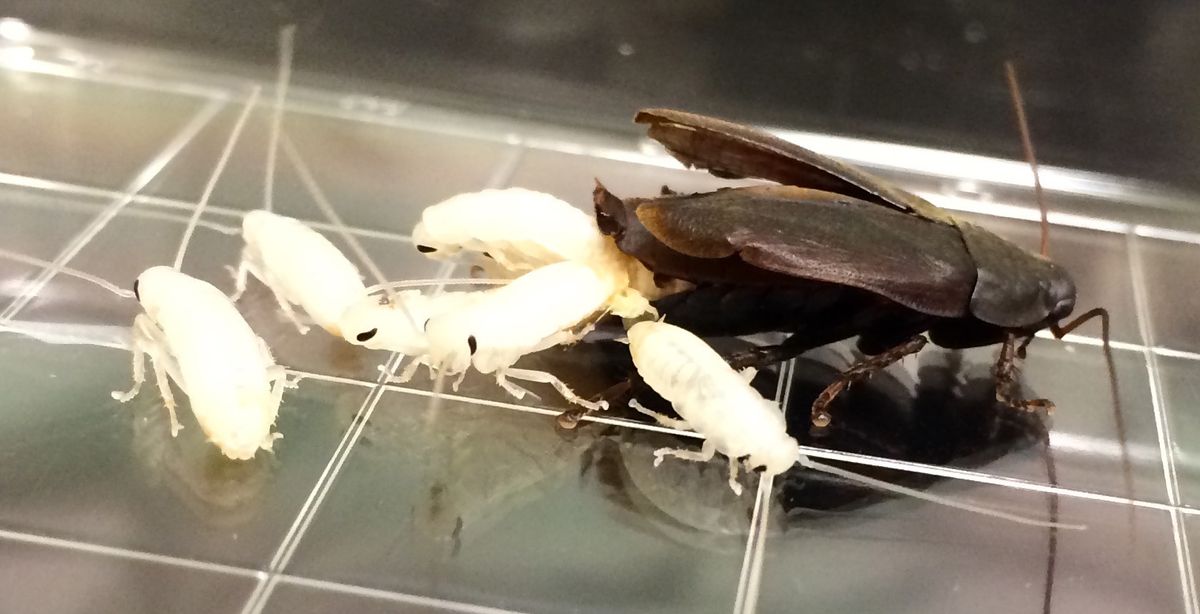Mom Genes: This Cockroach Species' Live Births Are in Its DNA

A cockroach species is one of the only insects in the world that shares some notable traits with humans: Like humans, beetle mimic cockroaches give live birth to their young, and they also seem to be able to provide nutrients from their bodies to their young, similar to the nourishment provided by breast-feeding in humans.
Now, one researcher is learning how these creatures developed these traits on the genetic level, and the findings might help to explain these roaches' very mammal-like behaviors.
The beetle mimic cockroach (Diploptera punctata) is not the same pest you might see scurrying around on your kitchen floor; it is a much smaller species of cockroach that is native to the tropical forests of the Polynesian islands. This cockroach is also one of the few insects that give birth to live young instead of laying eggs.
"Not only are they carrying their offspring, but they are prodding them with a milky secretion," Emily Jennings, a doctoral student in the University of Cincinnati Department of Biological Sciences and the lead researcher on this project, told Live Science. The milky secretion is made up of carbohydrates, protein and other nutrients necessary for baby roaches, she explained. [20 Startling Facts About Insects]
To learn more about what happens when a beetle mimic cockroach gets pregnant, Jennings examined the insects' RNA, or ribonucleic acid. This molecule stores information that is essential for carrying out all of the instructions stored in an organism's DNA — sort of like an instruction manual with all of an organism's genetic information. Whereas the study of DNA by itself is very important for understanding how different functions can work, RNA tells scientists which genes are actually active in the body, according tothe U.S. National Institutes of Health.
When Jennings started this project, there were fewer than 100 genes that had been identified for the beetle mimic cockroach, she told Live Science. Now, Jennings and her colleagues have found more than 11,000 beetle mimic cockroach genes. Although they haven't yet sequenced the genome, or decoded the entire genetic formula, for this insect, Jennings has started to look more closely at a few that affect the female cockroach during pregnancy.
She and her colleagues found several genes that were specifically associated with pregnancy in the female cockroach. There were a lot of genes associated with metabolism — functions like lipid metabolism and nitrogen metabolism pathways that clearly were expressed more during pregnancy, Jennings said.
Sign up for the Live Science daily newsletter now
Get the world’s most fascinating discoveries delivered straight to your inbox.
It's important for scientists to understand how metabolism functions during pregnancy because it dictates how certain nutrients are stored in the female body to nourish the developing offspring. For example, scientists think pregnant women's metabolism changes to build up proteins in the muscles as a reserve for later, according to research from scientists at the University of Cambridge. They also found a protein associated with the successful production of the mother cockroach's milky secretion.
In previous research, researchers found that there were some juvenile hormones in insects that played a huge role in development and reproduction, and almost every insect biological function. The hormone completely inhibits the production of the milky secretion, Jennings said.
Jennings and her colleagues now have a much clearer understanding of what's going on during different stages of the beetle mimic cockroach's pregnancy.
Jennings hopes her research has set the stage to begin a whole genome sequence for this cockroach species. She said she hopes it will help to unravel an interesting reproductive puzzle in convergent evolution — living organisms that evolve the same traits independently from one another. In this case, the beetle mimic cockroach and mammals both evolved to birth live young, but they did so on different branches of the evolutionary tree.
"Reproduction where the mom gives live birth has evolved in the animal kingdom independently 200 times," Jennings said. Biologists have known about this for a long time but stilldon'tcompletely understand how it happens, she said.
Jennings also wants to unravel some mysteries about what it takes for an insect to successfully give live birth and raise offspring. "[Live birth reproduction] can have a long-term impact on the mom and the babies after they are born," Jennings said. "Babies are greedy. And the mom wants to give them everything that she can while still maintaining her own health and fitness."
If scientists can understand how these stresses and pressures affect pregnant and mama cockroaches, it might be possible to model this same phenomenon in mammals or other insects, Jennings told Live Science.
Jennings presented her findings Jan. 7 at the national meeting of the Society for Integrative and Comparative Biology in Portland, Oregon.
Follow Elizabeth Newbern @liznewbern. Follow Live Science @livescience, Facebook & Google+. Original article on Live Science.
Most Popular

